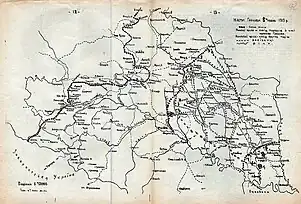Chortkiv offensive
The Chortkiv Offensive (Ukrainian: Чортківська Офензива, Чортків, Polish: Czortkowska Ofensywa, Czortków; 7–28 June 1919). During the Polish-Ukrainian War in 1918–1919, was one of the best counteroffensive military operations of the Ukrainian Galician Army against the Polish Army. Around 19,000–20,000 Ukrainians pushed back the Poles along the entire front of the 39,000–40,000 thousand strong and well-armed Polish Army, reinforced by the French Third Republic. As a result, around 120 kilometers of the territory claimed by the West Ukrainian People's Republic was taken and liberated from the Poles by the Ukrainian forces. Just because of lack of weapons and logistical problems on the Ukrainian side prevented the Second Polish Republic from a more serious military defeat.[3]
| Chortkiv Offensive | |||||||
|---|---|---|---|---|---|---|---|
| Part of the Polish-Ukrainian War (1918–1919) | |||||||
 Map of the Ukrainian Offensive in June 1919 | |||||||
| |||||||
| Belligerents | |||||||
|
|
| ||||||
| Commanders and leaders | |||||||
|
|
| ||||||
| Strength | |||||||
|
|
| ||||||
The disputed territory was claimed by the nascent Ukrainian State of the last Ukrainian Hetman Pavlo Skoropadskyi, the Western Ukrainian People's Republic, which also was disputed by the Ukrainian People's Republic and the recently re-established Second Polish Republic. The area of the West Ukrainian People’s Republic was claimed between these three groups was a mixture of Ukrainian, Polish and Jewish peoples intermixed throughout the Ukrainian area.
The offensive was initially and almost successful, with the Ukrainian forces successfully taking and liberating a vast swathe of the West Ukrainian People’s Republic territory.[4] however in the end of June the Ukrainian Offensive was repelled by the overwhelming numerical superiority of the Polish forces who were supported by the French Third Republic that pushed the Ukrainians back. Eventually, the interwar future of Galicia was decided at the Allied Council of Foreign Ministers in the Paris Peace Conference in 1919–1920, that officially hostilities were ceased, the Ukrainian Galician Army evacuated at the Zbruch River due to lack of ammunition.[5][6]
Goals
The Ukrainian Goals of the offensive (part of the Polish-Ukrainian War) was to push the Polish Army back to the Zolota Lypa River in order to improve morale among the Ukrainian Galician Army and locals by mobilizing a larger forces to push the Poles back past Lviv, Peremyshl, Kholm, Lublin and other claimed territories by the West Ukrainian People’s Republic in 1 November 1918. The Ukrainian forces wanted to liberate the Ukrainian territories from the Second Polish Republic who took it over in the recent years.
Ukrainian offensive
On 8 June 1919, the Ukrainian Galician Army numbering around 19,000–20,000 men assaulted Chortkiv, forcing the Poles to retreat to the Holohory–Peremyshliany–Bukachivtsi frontline. Under the command of the Ukrainian General Oleksandr Hrekiv, the Ukrainian forces came close to Lviv, the main city of the province, and almost took it from the Polish forces, which was their greatest success.[5]
The Ukrainian forces also gained victories at Yahilnytsia (7–8 June), Chortkiv (8 June), Vyhnanka (8 June), Bilobozhnytsia (9–10 June), Kopychyntsi (10 June), Yazlovets (11–12 June), Buchach (12 June), Terebovlya (12–13 June), Monastyryska (13 June), Ternopil (14 June), Kozova (14 June), Nyzhniv (14–15 June), Pidhaytsi (15–16 June), Berezhany (20–21 June), Zboriv (21 June), Zaliztsi (21–22 June), Rohatyn (22 June), Zolochiv (22 June), Burschtyn (23 June), Brody (24 June).[5][7]
Polish counterattack
As the Ukrainian Galician Army suffered from a lack of ammunition, on 28 June a better equipped and much larger Polish forces broke through the Ukrainian lines at Janczyn and forced the Ukrainian forces to retreat and evacuated at the Zbruch River.[5][7] Eventually the Ukrainians were forced back toward the Dnipro Valley which then was controlled by the Ukrainian People's Republic, another nascent Ukrainian State of the last Ukrainian Hetman Pavlo Skoropadskyi did not hold the same territorial aspirations as its ethnic neighbor. Due to the support of the French Third Republic in this war and the offensive, the Polish Army was able to obtain and assemble a much larger and more powerful force of around 39,000–40,000 men against the Ukrainian Galician Army, and the Ukrainians were forced to return to their previous positions and abandon the cities and villages they had liberated during their recent offensive.[7]
Aftermath
Though the Ukrainian Galician Army initially experienced numerous early victories, the numerical and technical superiority of the Polish forces ended its rule. In 18 July 1919, West Ukrainian People’s Republic stopped its exist as an independent state and were forcefully integrated into the Second Polish Republic.
Notes
- Institute of History of Ukraine, “Chortkiv Offensive Operation of the Ukrainian Galician Army”.
- Marek Krotofil, “Analiza stanu liczebnego Ukraińskiej Armii Halickiej // «Nad Wisłą i Dnieprem. Polska i Ukraina w przestrzeni europejskiej-przeszłość i teraźniejszość”.
- OLIINYK, Serhii (2019). "THE PODILIAN PAGE IN THE HISTORY OF THE UKRAINIAN GALICIAN ARMY IN THE MEMOIRS OF CONTEMPORARIES". Ukraine: Cultural Heritage, National Identity, Statehood. 32: 222–237. doi:10.33402/ukr.2019-32-222-237. ISSN 2223-1196.
- Subtelny
- Kubiyovych
- Encyclopedia of Ukraine
- Pidkova
References
- Chortkiv offensive at the Encyclopedia of Ukraine
- Subtelny, Orest (2000). Ukraine: A History. University of Toronto Press. pp. 370. ISBN 0-8020-8390-0.
- Kubiyovych, Volodymyr, Kuzelia, Zenon. Entsyklopediya Ukrainoznavstva (Encyclopedia of Ukrainian studies), 3 volumes (1994). Kiev. ISBN 5-7702-0554-7 (in Ukrainian)
- Ihor Pidkova (editor), Roman Shust (editor), "Dovidnyk z istorii Ukrainy Archived 2009-04-10 at the Wayback Machine", 3 Volumes, "(t. 3) Archived 2020-01-30 at the Wayback Machine, Kiev, 1993-1999, ISBN 5-7707-5190-8 (t. 1), ISBN 5-7707-8552-7 (t. 2), ISBN 966-504-237-8 (t. 3). Article: Чортківський наступ 1919 Archived 2012-01-21 at the Wayback Machine (in Ukrainian)